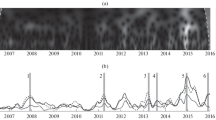Abstract
Detection of cosmic ray fluxes makes it possible to study dynamics of the interplanetary magnetic field and gain information about processes that occur both on the solar surface and in the entire Solar system. The main variations in the cosmic ray intensity are 27-day variations and Forbush effects. These variations are caused by complex spatial solar-plasma formations resulting from various processes on the solar surface and propagating in space with widely varying velocities. The data recorded by the PAMELA magnetic spectrometer on board the Resurs-DK1 satellite in 2006–2016 are used.












Similar content being viewed by others
REFERENCES
A. J. Hundhausen, Coronal Expansion and Solar Wind (Springer, Berlin, 1972).
F. Chen, Introduction to Plasma Physics and Controlled Fusion (Springer, Berlin, 2016).
J. O. Mathew and R. J. Forsyth, “The heliospheric magnetic field,” Liv. Rev. Sol. Phys. 10, 52 (2013).
G. H. Jones, A. Rees, A Balogh., and R.J. Forsyth, “The draping of heliospheric magnetic fields upstream of coronal mass ejecta,” Geophys. Res. Lett. 29 (11), 15-1 (2002).
J. T. Gosling and J. V. Pizzo, “Formation and evolution of CIRs and their 3-D structure,” Space Sci. Rev. 89, 21 (1999).
Y. M. Wang and N. R. Sheeley, Jr., “Solar wind speed and coronal flux tube expansion,” Astrophys. J. 355, 726 (1990)
D. J. McComas, H. A. Elliott, N. A. Schwadron, J. T. Gosling, R. M. Skoug, and B. E. Goldstein, “Wind around solar maximum,” Geophys. Res. Lett. 30 (10), 24-1 (2003).
J. V. Pizzo, “The evolution of corotating stream fronts near the ecliptic plane in the inner solar system,” J. Geophys. Res. 96, 5405 (1991).
Max Plank Institute for Solar System Research. https://www2.mps.mpg.de/en/aktuelles/pressenotizen/ pressenotiz_20081127.html
P. Picozza et al. (PAMELA Collab.), “PAMELA—a payload for antimatter matter exploration and light-nuclei astrophysics,” Astropart. Phys. 27, 296 (2007).
N. Gopalswamy, “Coronal mass ejections and solar radio emissions,” in Proceedings of the 7th International Workshop, Graz, Austria, September 15–17,2010, Ed. by H.O. Rucker, W.S. Kurth, P. Louarn, and G. Fischer (Austrian Acad. Sci. Press, Vienna, 2011), p. 325–342.
P. F. Chen, “Coronal mass ejections: Models and their observational basis,” Liv. Rev. Sol. Phys. 8, 1 (2011).
S. B. Pikelner, Fundamentals of Cosmic Electrodynamics (Fizmatlit, Moscow, 1961) [in Russian]
D. F. Webb and T. A. Howard, “Coronal mass ejections: Observations,” Liv. Rev. Sol. Phys. 9, 27 (2012).
H. V. Cane, “Coronal mass ejections and Forbush decreases,” Space Sci. Rev. 93, 55 (2000).
D. Alexander, T. H. Zurbuchen, and I. G. Richardson, “A brief history of CME science,” Space Sci. Rev. 123, 3 (2006).
I. G. Richardson and H. V. Cane, “Regions of abnormally low proton temperature in the solar wind (1965-1991) and their association with ejecta,” J. Geophys. Res. 100, 397 (1995).
T. L. Garrard, A. J. Davis, J. S. Hammond, and S. R. Sears, “The ACE science center,” Space Sci. Rev. 86, 649 (1998).
R. Munini et al. (PAMELA Collab.), “Evidence of energy and charge sign dependence of the recovery time for the 2006 December Forbush event measured by the PAMELA experiment,” Astrophys. J. 853, 6 (2018).
I. G. Usoskin, A. Gil, G. A. Kovaltsov, A. L. Mishev, and V. V. Mikhailov, “Heliospheric modulation of cosmic rays during the neutron monitor era: Calibration using PAMELA data for 2006–2010,” J. Geophys. Res. Space Phys. 122, 3875 (2017).
H. Moraal, “Cosmic-ray modulation equations,” Space Sci. Rev. 176, 299 (2011).
J. R. Jokipii, “Cosmic-ray propagation. I. Charged particles in a random magnetic field,” Astrophys. J. 146, 480 (1966).
A. Shalci, Nonlinear Cosmic Ray Diffusion Theories (Springer, Berlin, 2009).
J. R. Jokipii, H. Levy, and W. B. Hubbard, “Effects of particle drift on cosmic-ray transport. I. General properties, application to solar modulation,” Astrophys. J. 213, 861 (1977).
P. A. Isenberg and J. R. Jokipii, “Gradient and curvature drifts in magnetic fields with arbitrary spatial variation,” Astrophys. J. 234, 746 (1979).
R. A. Burger and D. J. Visser, “Reduction of drift effects due to solar wind turbulence,” Astrophys. J. 725, 1366 (2010).
E. N. Parker, “The passage of energetic charged particles through interplanetary space,” Planet. Space Sci. 13, 9 (1965).
S. C. Chapra and R. P. Canale, Numerical Methods for Engineers (Tata McGraw-Hill, New Delhi, 2015).
M. S. Potgieter and D. Bisschoff, “New local interstellar spectra for protons, helium and carbon derived from PAMELA and Voyager 1 observations,” Astrophys. Space Sci. 361, 48 (2016).
L. M. M. L. Batalha, “Solar modulation effects on cosmic rays. Modelization with force-field approximation, 1D and 2D numerical approaches and characterization with AMS-02 proton fluxes,” PhD thesis (Instituto Superior Tecnico, Universidade Tecnico de Lisboa, 2012).
R. Du Toit Strauss and E. Frederic, “A hitch-hiker’s guide to stochastic differential equations. Solution methods for energetic particle transport in space physics and astrophysics,” Space Sci. Rev. 212, 151 (2017).
Funding
The work was supported by grant MK-6160.2018.2 and the Ministry of Education and Science of the Russian Federation.
Author information
Authors and Affiliations
Corresponding author
Rights and permissions
About this article
Cite this article
Lagoida, I.A., Voronov, S.A. & Mikhailov, V.V. Origin of the Short-Term Variations of the Cosmic Ray Flux. Phys. Part. Nuclei 50, 826–835 (2019). https://doi.org/10.1134/S1063779619060054
Received:
Revised:
Accepted:
Published:
Issue Date:
DOI: https://doi.org/10.1134/S1063779619060054




